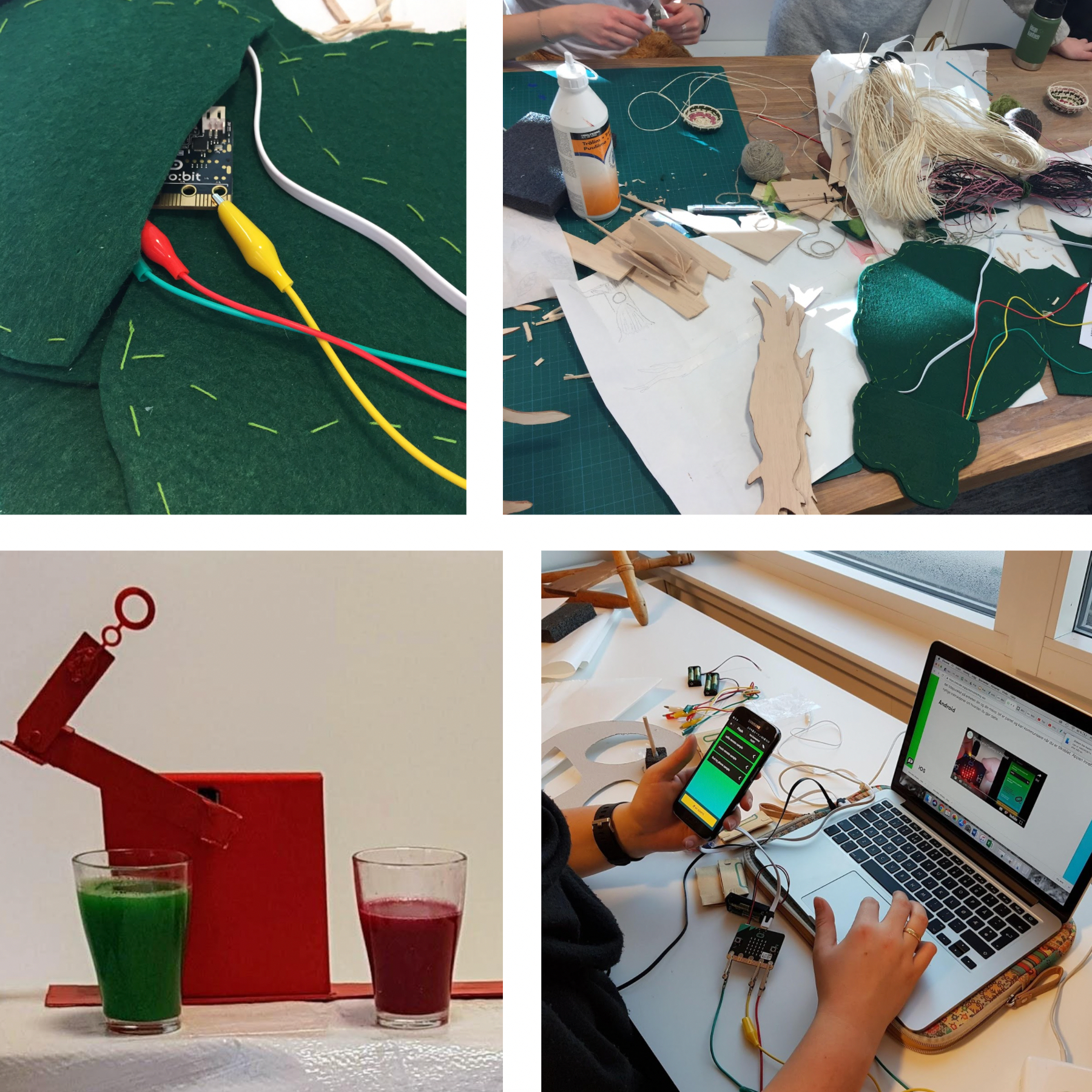Learning about materiality through tinkering with Micro:bits
DOI:
https://doi.org/10.7577/formakademisk.4636Emneord (Nøkkelord):
Art and design education, materiality, programming, Micro:bits, citizenshipSammendrag
This paper discusses two pilot projects in Art and design education at the teacher training at Western Norway University of Applied Sciences. In the second round of drafts for the new curriculum of Art and design digital knowledge is described as stretching from using simple digital resources to master and shape your own digital products. It is no longer limited to two-dimensional visual modelling as previously drafted. This is in our view a new approach in a subject where making, tinkering and designing allows for explorations in both 2D and 3D. Given that we want to encourage the use of the digital together with the use of physical materials, the pilot case studies demonstrate the importance of bringing coding and the material aspects of tinkering, making, and creating into play. The BBC Micro:bit was used to make coding and mechanical control part of projects made with traditional material. Further research and development should be undertaken to bring such practices into classrooms in primary and lower secondary schools.
Referanser
Digranes, I., & Fauske, L. B. (2010). The Reflective Citizen – General Design Education for a Sustainable Future. In C. Boks, C. McMahon, W. Ion, & B. Parkinson (Eds.), When Design Education and Design Research Meet. The 12th International Conference on Engineering and Product Design Education (pp. 364-369). The Design Society. https://hdl.handle.net/10642/539
European Commission. (2015). Science Education for Responsible Citizenship. http://ec.europa.eu/research/swafs/pdf/pub_science_education/KI-NA-26-893-EN-N.pdf
European Design Leadership Board. (2012). Growth and Prosperity (Report and Recommendations of the European Design Leadership Board). http://europeandesigninnovation.eu/wp-content/uploads/2012/09/Design_for_Growth_and_Prosperity_.pdf
Hoem, J. & Schwebs, T. (2005). Personal publishing and media literacy. http://hdl.handle.net/11250/2481567
Knutsen, J., & Morrison, A. (2010). Have you heard this? Designing mobile social software. FormAkademisk, 3(1). https://doi.org/10.7577/formakademisk.188
Meld. St. 20 (2015-2016). Fag – fordypning – forståelse: en fornyelse av Kunnskapsløftet [Subjects – specialization – understanding: a renewal of the Knowledge Promotion]. Kunnskapsdepartementet. https://www.regjeringen.no/no/dokumenter/meld.-st.-28-20152016/id2483955/sec1
Manovich, L. (2002) Who is the Author? Sampling / Remixing / Open Source. http://manovich.net/content/04-projects/035-models-of-authorship-in-new-media/32_article_2002.pdf
Medietilsynet (2018). Barn og medier undersøkelsen 2018: 9-18 åringer om medievaner og opplevelser [Children and media survey 2018: 9-18-year-olds about media habits and experiences]. https://www.medietilsynet.no/globalassets/publikasjoner/barn-og-medier-undersokelser/barn-og-medier-2018-oppdatert-versjon---oktober-2019.pdf
Mäkelä, E. (2011). Slöjd som berättelse – om skolungdom och estetiska perspektiv [Handicraft as a story – about schoolchildren and aesthetic perspectives]. (Doctoral dissertation in Pedagogical work, no. 41, Umeå universitet). https://www.skolporten.se/forskning/avhandling/slojd-som-berattelse-om-skolungdom-och-estetiska-perspektiv/
Nielsen, L. M., & Digranes, I. (2012). Designkompetanse i et gjennomgående utdanningsløp [Design competence in a continuous educational course]. Techne series : Research in sloyd education and crafts science. A, 19(1), 17-24. https://journals.oslomet.no/index.php/techneA/article/view/394
Papert, S. (1980). Mindstorms: children, computers, and powerful ideas. Basic Books.
Randers-Pehrson, A. (2016). Tinglaging og læringsrom i en kunst- og håndverksdidaktisk kontekst [‘Thing-making’ and learning space in an Art and crafts educational context]. (PhD, University of Oslo). http://urn.nb.no/URN:NBN:no-56700
Resnick, M., & Rosenbaum, E. (2013). Designing for Tinkerability. In M. Honey & D. Kanter. (Eds.), Design, Make, Play: Growing the Next Generation of STEM Innovators (pp. 163-181). Routledge. https://doi.org/10.4324/9780203108352-15
Keune, A. & Peppler, K. (2018). Materials-to-develop-with: The making of a makerspace. The British Journal of Educational Technology, 50(1), 280–293. https://doi.org/10.1111/bjet.12702
Schön, D. (1983). The reflective practitioner: How professionals think in action. Maurice Temple Smith.
Smeda, N., Dakich, E., & Sharda, N. (2014). The effectiveness of digital storytelling in the classrooms: a comprehensive study. Smart Learning Environments, 1(1), 1-21. https://doi.org/10.1186/s40561-014-0006-3
Stake, R. E. (2000). Case studies. In N. K. Denzin & Y. S. Lincoln (Eds.), Handbook of qualitative Research (pp. 86-109). Sage Publications.
Udir. (2018). Professional Digital Competence Framework for Teachers. https://www.udir.no/globalassets/filer/in-english/pfdk_framework_en_low2.pdf
Udir. (2019). Fagfornyelsen 2020. Høring på Kunst og håndverk. [Knowledge Promotion 2020. Hearing on Art and Crafts] https://hoering.udir.no/Hoering/v2/341?notatId=680
Udir. (n.d). Core curriculum – values and principles for primary and secondary education. https://www.udir.no/lk20/overordnet-del/?lang=eng
UNESCO. (2010). Citizenship Education for the 21st Century. http://www.unesco.org/education/tlsf/mods/theme_b/interact/mod07task03/appendix.htm
Verostko, R. (1994). ALGORITHMIC ART. Composing the Score for Visual Art. http://www.verostko.com/algorithm.html
Yin, R. K. (2003). Case study research. Design and methods (3rd ed.). Sage Publications.

Nedlastinger
Publisert
Hvordan referere
Utgave
Seksjon
Lisens
Opphavsrett 2021 Ingvild Digranes, Jon Hoem, Arnhild Liene Stenersen

Dette verket er lisensiert under Creative Commons Attribution-NoDerivatives 4.0 International License.
- Forfatteren(e) beholder sin opphavs- og kopieringsrett til eget manuskript, men gir tidsskriftet varig rett til 1) å fremføre manuskriptet for offentligheten i den opprinnelig publiserte digitale form, og 2) å registreres og siteres som første publisering av manuskriptet.
- Forfatteren må selv forvalte sine økonomiske kopieringsrettigheter overfor eventuell tredjepart.
- Tidsskriftet gir ingen økonomisk eller annen kompensasjon for innsendte bidrag, medmindre det er gjort særskilt avtale om dette med forfatteren(e).
- Tidsskriftet plikter å arkivere manuskriptet (inklusive metadata) i den opprinnelig publiserte digitale form, i minst ett dertil egnet åpent tilgjengelig langtidsarkiv for digitalt materiell, som for eksempel i de norske universitetenes institusjonsarkiv innen rammen av NORA-samarbeidet.
Verket vil bli publisert OpenAccess med en Creative Commons 4.0-lisens som tillater alle å lese, dele og tilpasse innholdet, også kommersielt, under lisensvilkårene:
Dette verket må tilskrives/ krediteres på riktig måte, en lenke må gis til CC-BY 4.0-lisensen, og endringer som er gjort må angis på en rimelig måte, men ikke på noen måte som antyder at lisensgiveren støtter deg eller din bruk.



